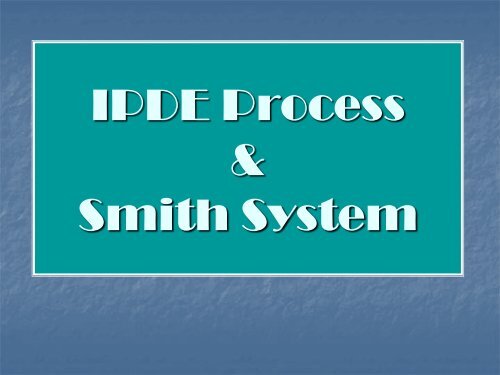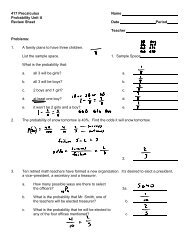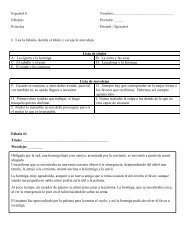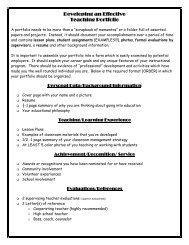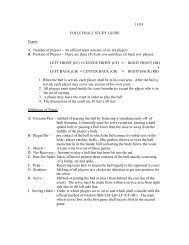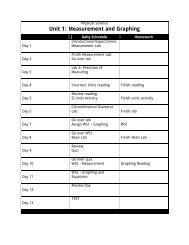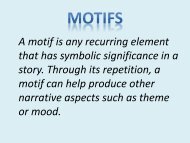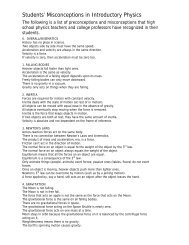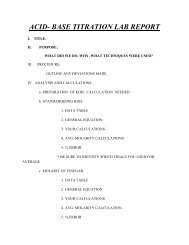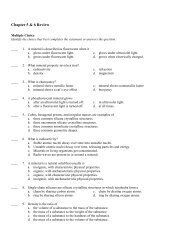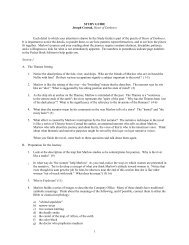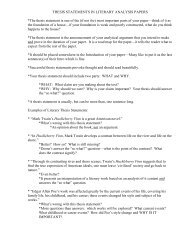You also want an ePaper? Increase the reach of your titles
YUMPU automatically turns print PDFs into web optimized ePapers that Google loves.
<strong>IPDE</strong> <strong>Process</strong><br />
&<br />
Smith System
<strong>IPDE</strong> <strong>Process</strong>:<br />
4 steps…<br />
• I = Identify<br />
• P = Predict<br />
• D = Decide<br />
• E = Execute
Identify<br />
• Accurate picture of the scene in order to<br />
identify any critical objects.<br />
• Vision<br />
• Space cushion – Space around your vehicle<br />
• Field of vision – everything you can see<br />
while looking straight ahead<br />
• Sight distance – distance you see ahead<br />
• Auditory<br />
• Honking horns, train horn, siren, squealing<br />
tires
Predict<br />
• Predict possible outcomes.<br />
• Traffic laws <strong>and</strong> controls, physical forces, <strong>and</strong><br />
reading other driver on the road.<br />
Important questions are:<br />
Which of these could cause a threat?<br />
Which ones are potential hazards?<br />
Which are real hazards?
Decide<br />
• Planning a course of action.<br />
• Escape path – where to go incase of<br />
an unexpected conflict.<br />
• Safe path of travel – path free of all<br />
hazards.<br />
• Minimize – putting more space<br />
between you <strong>and</strong> a potential hazard.<br />
• Separating – h<strong>and</strong>ling one hazard at a<br />
time.
Execute<br />
Taking action…<br />
A driver has three courses of<br />
action:<br />
1. Accelerate<br />
2. Brake<br />
3. Steer to left or right.
Smith System<br />
Five points:<br />
1. Aim High Steering<br />
2. Get the Big Picture<br />
3. Keep Your Eyes Moving<br />
4. Leave Yourself an Out<br />
5. Make Sure They See You
Aim High Steering<br />
• Keep 12 – 15 seconds of eye lead-time<br />
• Look ahead, far ahead.<br />
• Look far down the road, where the road<br />
disappears.<br />
• Know Field of vision.<br />
• Peripheral Vision – how far a person<br />
can see to the right <strong>and</strong> left while<br />
looking straight.<br />
• Central Vision – area in your central<br />
vision where you can see clearly while<br />
looking straight.
Get the Big Picture<br />
Be Aware of all objects &<br />
obstacles:<br />
• 1 - 2 city blocks ahead.<br />
• ½ mile on highways, expressways &<br />
country roads.<br />
• Sidewalk to Sidewalk.<br />
• All of the area around your vehicle.
Keep Your Eyes Moving<br />
• Check mirrors every 5 – 8 seconds.<br />
• Scan your eyes every 2 seconds.<br />
• Never stare at an object for more than 2<br />
seconds.<br />
• Eliminate Eye Holding Problems.<br />
• Adjust Speed: Speed up or slow down<br />
• Change Lanes.<br />
• Adjust Radio: Turn on music, turn up music,<br />
turn down music, <strong>and</strong> change station…<br />
• Roll down window, turn up air conditioner, <strong>and</strong><br />
turn off heater.<br />
• Sing or talk to yourself or others.<br />
• Pull over, take a break or get rest.
Leave Yourself an Out<br />
• Leave a 1 car-length space cushion at stop signs<br />
<strong>and</strong> intersections. (Stop so you can see their<br />
tires!)<br />
• Keep at least a 2 seconds following distance in<br />
front of your vehicle. (If possible 4 seconds).<br />
• Keep at least a 3-4 seconds following distance<br />
during adverse weather.<br />
• Eliminate Tailgaters:<br />
• Adjust Speed: Speed up or slow down.<br />
• Change Lanes.<br />
• Allow them to pass: Pull over to the side of the road or<br />
turn off on to anther road.<br />
• Signal a warning:<br />
• Turn on / Turn off Headlights.<br />
• Machine gun brake tap.
Make Sure They See You<br />
COMMUNICATION:<br />
• Make Eye Contact.<br />
• Honk Horn (Twice).<br />
• Turn on / Turn off Headlights.<br />
• Brake Tap.<br />
• Use turn signals.
<strong>Review</strong> <strong>Game</strong><br />
Let’s PLAY!!!
Name 3 potential hazards.<br />
#1
#2<br />
What are the five steps to the<br />
Smith System?
What does <strong>IPDE</strong> st<strong>and</strong> for?<br />
#3
#4<br />
Explain the Smith “leave<br />
yourself an out” step.
#5<br />
Define Separating.<br />
When might I use this.
#6<br />
How do we prepare for a<br />
traffic light?
#7<br />
Define space cushion.<br />
What will a space<br />
cushion allow me, the<br />
driver, to do?
#8<br />
Define field of vision.<br />
Why is this important?
#9<br />
When executing what are<br />
your three courses of<br />
action?
#10<br />
What is an escape path?
#11<br />
What do we call a light<br />
that has been green for<br />
a long time?
#12<br />
What does field of vision<br />
mean? And how will I<br />
use it?
#13<br />
What <strong>IPDE</strong> step tells me<br />
what might happen?
#14<br />
What <strong>IPDE</strong> step helps you<br />
become aware of<br />
problems?
#15<br />
What <strong>IPDE</strong> step tells me<br />
what action to take?
#16<br />
Explain the Smith “keep<br />
your eyes moving” step.
#17<br />
How far ahead should we<br />
be looking <strong>and</strong><br />
planning?
#18<br />
What is the point at an<br />
intersection where we<br />
should go through a<br />
yellow light called?
#19<br />
What does aiming high<br />
mean?
#20<br />
Explain the Smith “get<br />
the big picture” step .


